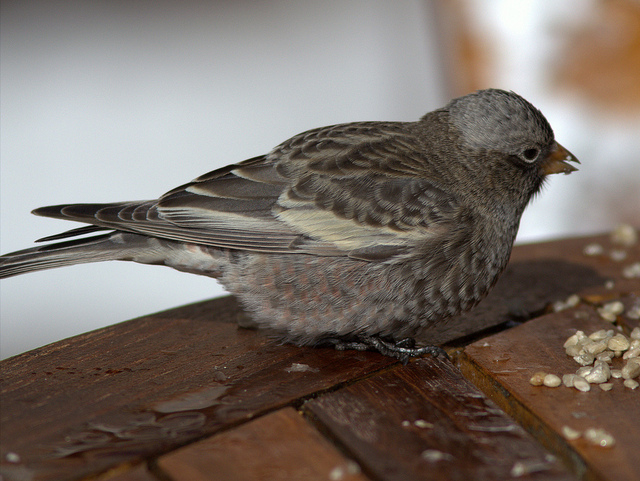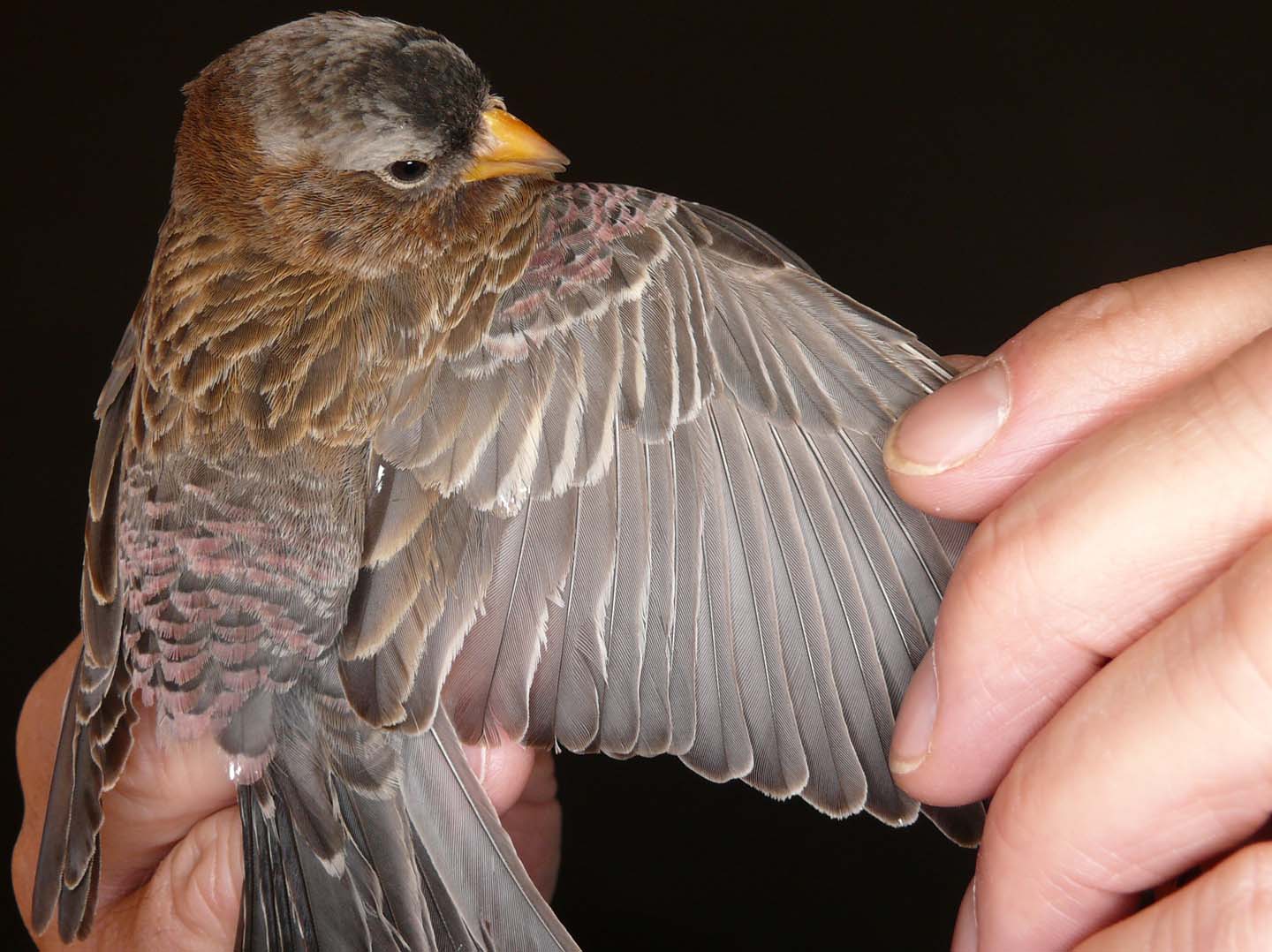Sandia Crest Birding FORUM
›
ARCHIVED Rosy-Finch Observations and Banding Reports PRIOR WINTER 2011-2012
Photos and ID issues: The first Brown-capped Rosy-Finch appeared November 14
|
Administrator
|
This post was updated on .
Mary Lou and I visited Sandia Crest on November 12 and 14. We saw one Gray-crowned and up to 13 Black Rosy-Finches in flocks that visited every 15 - 30 minutes and did not linger. There was a light snow on the 13th and we stopped at Doc Long Picnic Area on the way up as rain began to fall. As it turned out, we missed seeing Steve and Nancy Cox, master banders who supervise the Sunday morning Rosy-Finch banding operation which is tentatively scheduled to begin on November 27. The Crest House manager, Gene Romero, was the first to call out the identity of the single Brown-capped Rosy-Finch that visited on the 14th.
On November 12 it was quite clear. This is the view from the deck of the Crest House:  Hoar Frost, Ellis Trailhead--Passing clouds created hoar frost that added to the light coating of snow. Images from Sandia Crest House, November 14, 2011. It was 22 degrees at 11:00 AM and it had snowed the previous night. The road was clear except for patches of snow and ice in the shaded curves (about the most hazardous spots for drivers who fail to slow down).  Later in this thread is an e-mail from Steve Fettig, who is an expert in the identification of immature rosy-finches. I have updated this post to include some of his very instructive comments. Please read his entire post, below. I also heard from Steve and Nancy Cox, in charge of the banding at Crest House. They also evaluated the photos and agreed with Steve.. : Brown-capped Rosy-Finch. Note its lack of a gray crown, brown hind-crown, overall brownish color, with bright pink on lower belly and wings. It is in adult plumage (and wears a leg band from a previous season to prove it): Steve Fettig's comments: Yes, it is a Brown-capped Rosy-Finch (BCRF). It is likely a male based the relatively pink belly color. In addition, as you have said, it is an adult, meaning it is an after-hatch year (AHY) bird, not only based on the band from last year, but there is a good amount of pink in the greater coverts. Look closely at the photo to see the pink in the primary coverts, which can suggest an AHY bird.  Two Black Rosy-Finches: Steve Fettig comments: This is a good photo to show the differences between male and female Black Rosy-Finches (BLRFs). The upper left bird is likely a hatch-year (HY) female. The very limited amount of pink in the belly points to female while the pale yellowish greater coverts point to the bird being an HY bird. The lower right bird is likely a HY male. The relatively pink belly points to male, while the pale yellowish greater coverts (as with the other bird) point to the bird being HY. Also, compare the amount of black in the caps of these two birds. Note that the female in the upper left has much more black in the crown than the male in the lower right.  Black immature vs Gray-crowned Rosy-Finch? Through the binoculars, this bird looked to be a Gray-crowned Rosy-Finch. It showed very little pink on the breast and wings, and appeared brown all over. It is most likely a hatch year bird, as it has light brown tips on its contour feathers. On examining the photo, it appears that the feather bases are actually quite black, probably indicating it is an immature female Black Rosy-Finch. Expert interpretations are invited! Steve Fettig's comments: I would agree it is an immature female Black Rosy-Finch. That dark feature centers on the upper back feathers seem too black for a Gray-crowned Rosy-Finch (GCRF).  Gray-crowned Rosy-Finch-- This bird is at least one year old, as evidenced by its leg band, and its plumage is overall brown with only faint rosy tint on its lower abdomen and no color on wings. I believe it is most likely an adult female Gray-crowned Rosy-Finch, but I stand corrected if someone on the banding team disagrees. Steve does indeed disagree: I would suggest that this bird is an female Black Rosy-Finch (BLRF). Here the lighting from the side may be creating a slightly soft view of the birds, which may confuse the ID. You got the gender correct, female by only faint rosy tint on its lower abdomen…” I would suggest saying limited pink in the wings, rather than “… no color on wings” since there is some pink in the outer greater coverts, which confirms female. A BLRF is more likely than a GCRF based on the dark centers to the feathers, and the whitish edging to large numbers of body feathers.  Black Rosy-Finch-- Gene Romero spread seed on the table tops, as the Stellers jays and Abert's Squirrels were dominating the feeders:  On November 12th, one of the visiting birders from Houston had to give the Abert's Squirrel a shove to make it leave the feeder: 
Crest House sign: 
Ken Schneider
Web site: http://www.rosyfinch.com Blog: http://rosy-finch.blogspot.com Photos: http://www.flickr.com/photos/rosyfinch/ |
|
Administrator
|
I just heard from Gil Bachmann, manager of the Kandahar Condos in Taos Ski Valley:
Hi, Ken. Two Rosy finches appeared at the feeder this past Saturday, November 12. Indeed, I'm watching them right now as I type this message. I'll let you know when the whole flock comes in. Gil Bachmann Kandahar Taos Ski Valley, NM Thanks, Gil-- I will be interested in hearing more about their arrival and abundance. We visited Sandia Crest this past week, and there were about a dozen. They came to the Crest a bit late this year. Would like to know when the large flocks arrive there and in TSV. If you see some banded birds, please let us know. You can also post directly to the FORUM.
Ken Schneider
Web site: http://www.rosyfinch.com Blog: http://rosy-finch.blogspot.com Photos: http://www.flickr.com/photos/rosyfinch/ |
|
Administrator
|
In reply to this post by Rosyfinch
At my request, Steve Fettig has commented upon the ID of the rosy-finches in my post at the top of this thread. In sum, Steve calls into question the ID of the presumed Gray-crowned Rosy-Finch that I photographed. As I noted, several immature Black Rosy-Finches looked quite brown in the field, but my photos subsequently proved them not to be Gray-crowned. Since the finch in "Photo #4" was the only one I saw over the two days of observation that I felt pretty sure about, and was lucky to be there for the first Brown-capped, this bird made me think I had a "Rosy-Finch Trifecta." I must agree with Steve that this is not the case. I hope we soon get some knockout photos of those nice cinnamon-colored adult Gray-crowns that will not leave us puzzled.
I really appreciate the ID tips that Steve has provided, and I hope that this helps us all! Ken Steve's e-mail follows-- Ken: Thanks for sharing the photos. Below are my comments. The first two photos are of landscapes and are very nice. Photo 1, “Brown-capped Rosy-Finch”: Ken, very nice photo. Yes, it is a Brown-capped Rosy-Finch (BCRF). It is likely a male based the relatively pink belly color. In addition, as you have said, it is an adult, meaning it is an after-hatch year (AHY) bird, not only based on the band from last year, but there is a good amount of pink in the greater coverts. Look closely at the photo to see the pink in the primary coverts, which can suggest an AHY bird. Photo 2, “Two Black Rosy-Finches”: Ken, very nice photo again. This is a good photo to show the differences between male and female Black Rosy-Finches (BLRFs). The upper left bird is likely a hatch-year (HY) female. The very limited amount of pink in the belly points to female while the pale yellowish greater coverts point to the bird being an HY bird. The lower right bird is likely a HY male. The relatively pink belly points to male, while the pale yellowish greater coverts (as with the other bird) point to the bird being HY. Also, compare the amount of black in the caps of these two birds. Note that the female in the upper left has much more black in the crown than the male in the lower right. Photo 3, “Black immature vs Gray-crowned Rosy-Finch”: Ken, I would agree it is an immature female Black Rosy-Finch. That dark feature centers on the upper back feathers seem too black for a Gray-crowned Rosy-Finch (GCRF). Photo 4, “Gray-crowned Rosy-Finch”: Ken, I would suggest that this bird is an female Black Rosy-Finch (BLRF). Here the lighting from the side may be creating a slightly soft view of the birds, which may confuse the ID. You got the gender correct, female by only faint rosy tint on its lower abdomen…” I would suggest saying limited pink in the wings, rather than “… no color on wings” since there is some pink in the outer greater coverts, which confirms female. A BLRF is more likely than a GCRF based on the dark centers to the feathers, and the whitish edging to large numbers of body feathers. I have attached two photos from our banding last winter may be helpful in comparison. Particularly notice photo #16 of the GCRF. Note the overall color of the back on this first-winter second-year female. Photo 5, “Black Rosy-Finch”: Ken, beautiful photo. Great depth of field. If you listen closely as these finches stand in the seed, you can hear them softly say, “oink oink oink” — just kidding. Based on the near lack of pink on the belly, this bird is likely a female. The front-on view gives very few clues to the bird’s age. Sincerely, Stephen (Steve) Fettig Images are copyrighted and property of Steven Fettig and all rights are reserved No. 15 Black-crowned Rosy-Finch Hatch Year Female 12 DEC 2010  No. 16 Gray-crowned Rosy-Finch Second Year Female 23 JAN 2011 
Ken Schneider
Web site: http://www.rosyfinch.com Blog: http://rosy-finch.blogspot.com Photos: http://www.flickr.com/photos/rosyfinch/ |
«
Return to ARCHIVED Rosy-Finch Observations and Banding Reports PRIOR WINTER 2011-2012
|
1 view|%1 views
| Free forum by Nabble | Edit this page |

